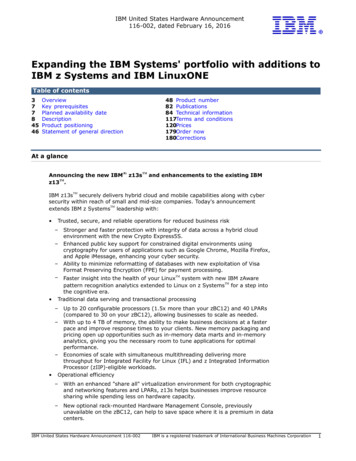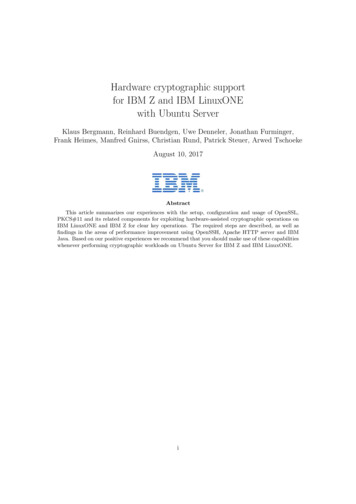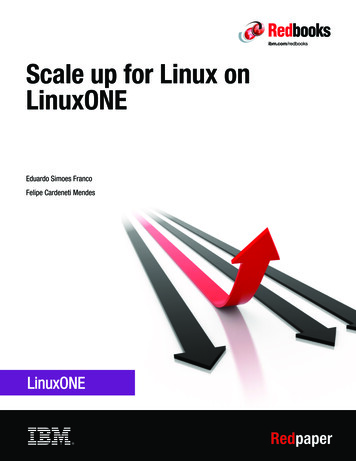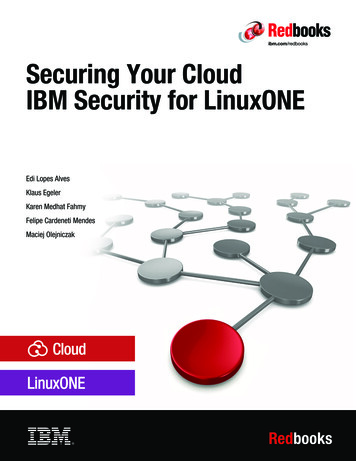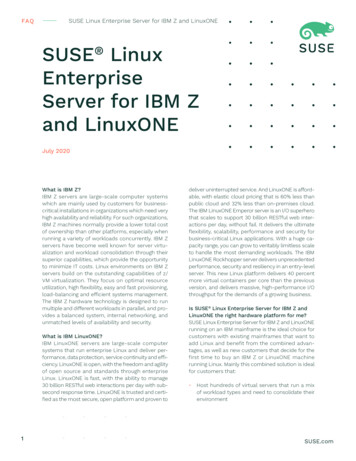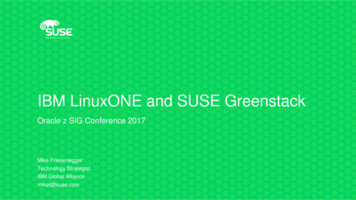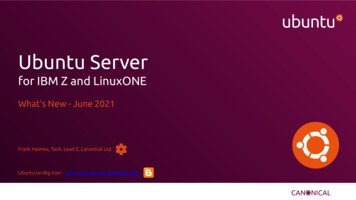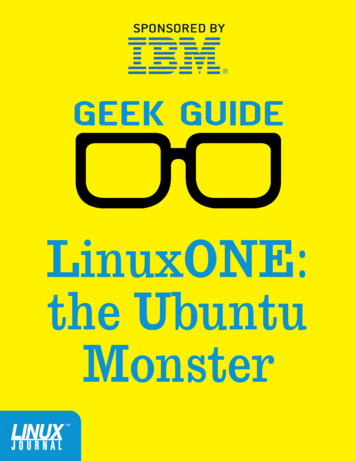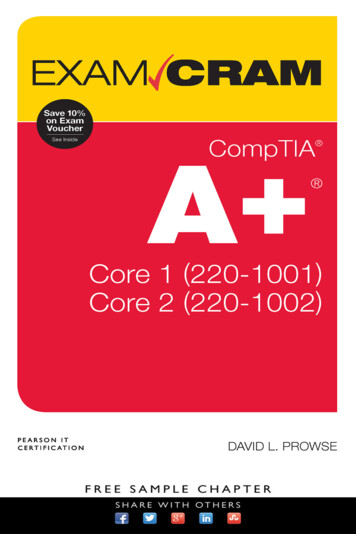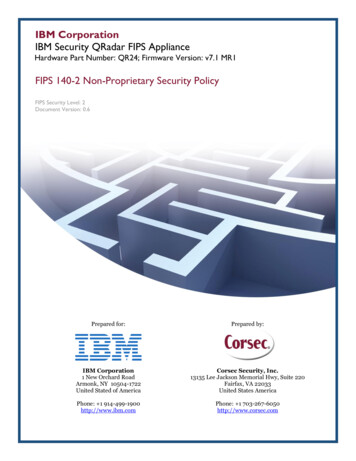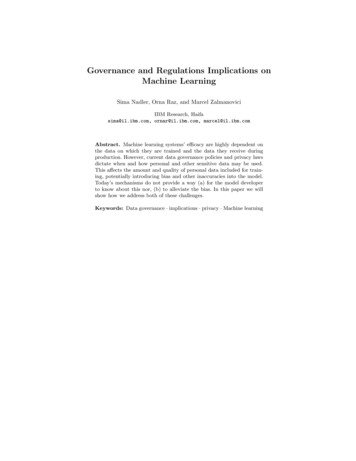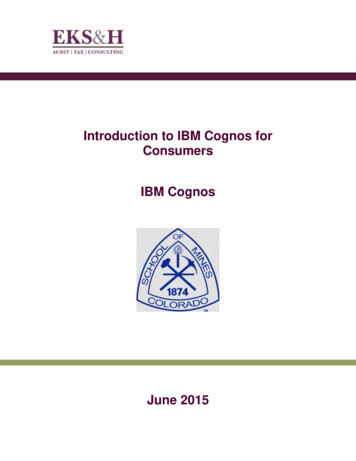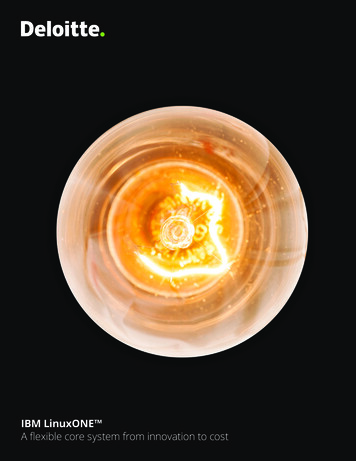
Transcription
IBM LinuxONE A flexible core system from innovation to cost
IBM LinuxONE A flexible core system from innovation to costIBM LinuxONE A flexible core system from innovation to costBalancing the coreOrganizations are racing to adopt newtechnology practices in an effort tomaintain their competitive advantage, if notsurpass the competition altogether, andexpedite innovation. In an era demandingscalability and flexibility, plagued withrestricted budgets, and that requires theutilization of core system investments,businesses have their hands tied.How does an organizationwith heavy investments in coresystems evolve to keep paceThe CIO wish listbetween business expectations and ITcapabilities were astonishing: 57 percent ofCIOs said innovation was the business’s coreexpectation of IT, but only 18 percent of CIOssaid that their IT capabilities for supportinginnovation and disruption were mature.1There are massive amounts ofopportunities available to companies thatare able to leverage data, but IT executives’constrained budgets challenge their abilityto bring innovation to the business as theytry to balance their trusted systems withnew, flexible systems.with data growth and processingPUSHINGBOUNDARIESwhile maintaining its budget?Transforming systems effectively requiresIT executives to balance the systems incore environments with new systems thatenable their businesses to leverage dataand innovate. However, budget constraintscan make it challenging to keep pace withthe demand on legacy systems and growingdata center footprints to accommodate newworkloads. One way to help cut costs hasbeen to migrate workloads to the cloud,but many companies have mission-criticalworkloads that are required to remain onlocal servers. Regardless of alternatives,in Deloitte’s Global CIO Survey, the G RISKAND SECURITYWhat are the business’s core expectations of IT?70%of CIOs saybusiness processimprovement70%of CIOs sayinnovation50%of CIOs saydigital41%40%28%30%18%20%core systems with new systems,provide the steadfastness of amainframe, but operate withflexibility in mind—connectivity,open systems, open standards,virtualization, containerization,open source?61%Balancing the Core46%of CIOs sayprojectexecutionof CIOs saytechnologyvisioncost-effective system to balanceIn comparison, the new systems handling flexibletechnologies tend to lack the steadfastness of legacysystems and can breed large data center footprints,increase risk, decrease performance, and increaseexecutive frustration. What many decision-makers thoughtmay be a lower-cost option for innovation led to everincreasing server sprawl costs.of CIOs saycybersecurity56%Wouldn’t it be nice if there was a67%of CIOs sayefficiency andcost reduction57%60%Traditionally, core systems equate to mainframes. Theywere, and are, recognized for their reliability, durability,availability, security, and high performance. Mainframesbecame trusted, fault-resistant systems that supported,and still support, many of the world’s largest corporations.They offer an organization dependable reporting andauditing. Core systems also take up little space on a datacenter floor, which reduces footprint costs by runningmass numbers of workloads on a single system instead ofrunning the same number of workloads on hundreds orthousands of smaller systems. Unfortunately, while legacysystems may excel in steadfastness and consolidation, theperception is that they often lack flexibility and have highoperating costs, inhibiting businesses from achieving costeffective innovation.35%of CIOs saystrategicalignmentof CIOs sayinnovationand disruptionof CIOs sayinfrastructuresimplification33%of CIOs sayinvestmentmanagement30%29%of CIOs sayrisk andsecurityRiskCostScaleInnovationof CIOs sayenterprisearchitectureWhat supporting IT capabilities are currently mature?Source: Deloitte Development LLC, 2016-2017 Global CIO Survey, 2016, dupress.deloitte.com/cio-survey; Survey question:What are the core expections from the business of your IT organization/CIO?; Survey question: How would you evaluateyour IT organization’s current capability across the following areas? “Mature” denotes respondents that selected “Leading”or “Excellent.”Figure 1. Deloitte 2016-2017 CIO Study3
IBM LinuxONE A flexible core system from innovation to costIBM has a present to deliver, and its nameis LinuxONETMIn August 2015, IBM announced a three-way strategy tobring flexibility and innovation to its legacy systems byembracing open-source-based technologies and opensource communities. This powerful solution combinationwas called LinuxONE.IBM LinuxONE A flexible core system from innovation to costTypical benefits ofcore computingTypical benefits ofopen Linux High availability Open source Performance Open standards Scalability Flexibility of choice Reliability Speed of innovationLinuxONE offers a new portfolio of hardware, software,and services solutions that provides two hardware solutionpackages, future support for open source solutions, anda contribution to the open source community to enablegreater access to the developer community.2By combining the power of the open source communitywith its knowledge in reliable mission-critical systems,IBM provides a viable solution for running open sourcesolutions at the core of organizations.IT executives no longer need to choose between reliableand predictable, dynamic and agile, or cost becauseLinuxONE helps close this gap. The LinuxONE platformbrings core stability to open source solutions, ultimatelyempowering companies to create innovative solutions at acompetitive price point.“We strongly believe thatwe need to leverage ourstrengths and invest inLinuxONE as (1) the bestdata serving platformin the world and (2) themost secure computingplatform in the world.”– Mark FigleyIBM LinuxONE Systems Offering Lead4An innovative, flexible core systemInnovation and flexibilityLinuxONE was designed with flexibility and innovation inmind to provide businesses with an option in addressingtechnology demands, on time, to the organization and itscustomers.CloudLinuxONE allows clients to use cloud and hardwareenvironments, offering choice with consistency via HybridCloud. The platform supports open source workloads,which run on Linux , in a secure, high-performance,scalable, and available environment. Controlled serversprawl Increased ROI Business innovationFigure 3. Typical benefits of core computing andopen Linux can provide business benefits.Cloud management features include IBM Wave software,which enables the simple configuration and provisioningof virtual machines, in addition to IBM’s z/VM hypervisor.For traditional Linux users, KVM virtualization andmanagement is also available.To aid incorporation of LinuxONE into a customer’senvironment, IBM offers LinuxONE platform integrationwith Openstack, the IBM Cloud Manager Appliance, andVMware’s vRealize Automation software. The platformcan also be connected through IBM’s platform-as-aservice, Bluemix , to enable the consumption of servicesin business applications via application programminginterfaces (APIs).Open source and open standardsIn addition to commercial Linux software solutions,the LinuxONE platform is positioned to make use ofopen source software solutions. LinuxONE permits thedeployment of many open source solutions that provideinnovative and differentiated services to customers. Someexample solutions include Apache Spark for real-timeinsights, smart city technologies, geospatial retail analytics,and financial credit management.VirtualizationLinuxONE’s virtualization capabilities allow firms toefficiently re-allocate resources between guests, usinghypervisor partitioning that is built into the firmware andthe platform’s elastic system that combines non-disruptivehorizontal and vertical scaling. The two LinuxONEhardware solutions, Rockhopper and Emperor, respectivelycan fit up to 1,000 VMs or 8,000 VMs in a single box.From a virtualization toolset point-of-view, there aretwo options to choose from: IBM z/VM or KVM. IBM z/VM heralds from heritage, mission-critical systems andprovides tight integration into the LinuxONE hardwarefeatures. To evolve z/VM, it is sometimes coupled withIBM Wave for z/VM, which is IBM’s enhanced interfacefor managing z/VM. To be able to gain the demonstratedbenefits from this virtualization layer, users with previousz/VM experience are recommended.Open source KVM is also available and is suited fororganizations that have existing skills around KVM.However, this virtualization layer is currently not as tightlycoupled with the LinuxONE hardware as z/VM, which limitsthe number of features that are available to KVM users.BlockchainLinuxONE provides two major features that may be ofinterest to businesses looking for a platform for innovativeblockchain solutions. The encryption features allow usersto run blockchain at level of encryption required in manyregulated industries and at a high speed.In addition, the use of IBM’s Secure Service Container, ahardened and encrypted version of its blockchain solution,allows users to run the solution, knowing that there isno administrative access without the master encryptionkey. This reduces the risk of impacting core businessapplications and is important considering 58 percent ofIT ops and security managers believe organizations aregranting unnecessary access to their staff.35
IBM LinuxONE A flexible core system from innovation to costRetaining the core strengthsLinuxONE was created with flexibility and innovation inmind. However, it incorporates its predecessor’s successesin high availability, performance, scalability, and security.Its core system has been running important workloads forgenerations and has demonstrated near-zero unplanneddowntime. The technology is in 96 of the world’s top 100banks, 23 of the top 25 US retailers, and 9 of the top10 biggest insurance companies,4 which alludes to thissystem’s ability to maintain its steadfastness.High availabilityLinuxONE’s platform provides high levels of availability—itsmean-time-to-failure is measured in decades, not singledigit years. The systems are built with reliability featuresthat include spare cores to allow additional redundancyand remove single points-of-failure. This is important whenconsidering how memory problems can be the cause ofsystem failures.LinuxONE embeds error detection into the componentsand includes built-in, automated diagnostics. Automatedfailover increases speed to recovery and reduces systemimpact. Installing, upgrading, and maintaining processorsis a non-disruptive process, enabling the system to runwithout downtime.5Performance—extra cores, multi-tier cache, high I/OPerformance enables increased capacity and decreasedlicensing costs. The LinuxONE platform includes IBM’spower systems technology and Simultaneous MultiThreading (SMT), which allows businesses to run multipleworkloads in parallel.Additionally, unlike many other platforms that are designedfor peak usage, LinuxONE can run at near 100 percentutilization, yielding less processor requirements (see Figure 4).6IBM LinuxONE A flexible core system from innovation to costTypical designfor peaksUnused capacityDesigned forpeak utilizationLinuxONEdesign for highutilizationShared for high utilizationUnused capacityUtilizationFigure 4. Example of what one may see regarding LinuxONE utilization in comparison totypical design utilization peaks.Scalability made easy—capacity-on-demand,multiple workloads, or VMs on one systemLinuxONE is a very competitive solution for scalability. Asorganizations develop innovative solutions, being able toimprove response times and add more capacity is crucial.LinuxONE enables scale out by adding additional Linuxvirtual servers, as well as scale up by adding memoryand processors. The configuration of the system enablesthe business to scale without disruption to the runningenvironment.Although 8,000 and 1,000 Linux servers are thearchitectural limit for Emperor and Rockhopper,respectively, the amount of volume capacity may bereduced if users incorporate Secure Service Containersinto the environment, and the actual number of volumesthat the systems can support is likely dictated by businessworkload requirements.SecurityLinuxONE provides one of the most secure, commerciallyavailable platforms for Linux. The systems provide tamperproof,built-in cryptographic cards and come with firmware-basedpartitioning, including EAL 5 workload isolation. Additionally,LinuxONE isolates at every level, running up to 80 LPARs toenable workload isolation and pooling of resources acrosspartitions or dedicated to individual partitions.The LinuxONE platform also allows users to take advantageof IBM’s security solutions, including IBM QRadar , whichprovides security monitoring and management. Identitymanagement, policy-based authentication, security zones,reporting, and auditing are additional features that areavailable to users to enable a secure data processingenvironment.The ability to consolidate workloads onto a single machinewith internal high speed networks means that it is possibleto decrease external network traffic, resulting in a reducedrisk profile.77
IBM LinuxONE A flexible core system from innovation to costIBM LinuxONE A flexible core system from innovation to costA cost-effective, flexible core systemLinux is everywhere. It is driving an open standards revolutionthat is now integrating with business-critical applications.IBM reports that Linux applications on blade servers aremore than 65 percent more expensive than on thoserunning in LinuxONE environments and that LinuxONEprovides a faster return on investment at a lesser totalcost of acquisition than that of blade server solutionsfor organizations having more than 20 Linux servers.6These figures indicate LinuxONE as a viable solution forconsideration for executives looking into consolidatingtheir IT footprint and/or achieving improved performance.Elastic pricingElastic, capacity-on-demand pricing allows the business topurchase the capacity that is desired and add more when it isneeded. Customers can pay-for-use, pay-per-core, or rent withno upfront payment and return after one year. Companiespurchase the desired number of active cores at a standardprice and optionally purchase “on demand,” self-managedinactive cores at a reduced price. This likely decreases thirdparty charges in maintaining the capacity. If users need an agile and effective hybrid cloudinfrastructure option to address new businessdemands with greater efficiency and low servicedelivery costsIBM LinuxONE has two pricing models: outright purchaseand elastic pricing. Additionally, a “try then buy” approachallows for contract cancellation after one year at no cost inmany cases. When users need to extract insights from data faster,by removing ETL processes, and scale to meet big dataand analytics demandsElastic, pay-by-use pricing may improve the attractivenessof the LinuxONE proposition, but organizations shouldconsider closely monitoring solution utilization so thebusiness budgets are not exceeded due to unplannedpeak periods and utilization.Pricing overviewThe LinuxONE portfolio offers hardware, software, and servicesthat combine the flexibility and agility of the open revolution fora cost-effective, enterprise-grade Linux environment.When does Linux make sense?Standard hardware pricingThe LinuxONE solution can be based on purchasing a setnumber of CPUs and memory. In addition, any requiredsoftware may be bundled into a single purchase price forthe solution. Software support and maintenance will bepaid on normal cycles that businesses are used to. CapacityBack-Up, an optional feature, enables users to have adisaster recovery site with sufficient capacity, which can beactivated in the event of a disaster. This also allows users todo disaster recovery testing at intervals as required. When users need to secure the business, whichrequires system designs that provide the highestcommercially available levels of securityWhat concerns does this address? Running large input/output (I/O) or cache intensiveworkloads (i.e., database or transaction processingapplications)ActualQ1Q2BaseQ3Q4Figure 6. Example elastic pricing model over the course of four quarters. Consolidating a large number of servers when abusiness suffers from increasing costs of server sprawl Gathering time-sensitive data that is driving the digitalagenda Reducing expensive software licensing costs over time Providing mandatory business uptime and security889
IBM LinuxONE A flexible core system from innovation to cost65.0Consolidation savingsDue to the nature of the technology used in the LinuxONEsolution, it is not a simple one-for-one modelling exerciseto determine the number of cores or amount of memoryusers may require. Users may experience various coreconsolidation ratios depending on the nature of theworkload, and it is not unusual to have anywhere in theregion of 20:1 to a maximum of 50:1 core consolidationratios when comparing with traditional x86 environments.Three-year comparison:100 new blade servers vs. LinuxONE60.055.050.0Total Cost (Millions)An initial view of costsIt is anticipated that commodity-based buyers likely lookat the raw cost of a server, which typically includes a lowerprice tag in comparison to the higher-cost LinuxONEhardware solutions. However, this should be vettedcarefully with a return on investment (ROI) and total cost ofownership (TCO) analysis to make sure the correct solutionfor controlling future growth costs is chosen.IBM LinuxONE A flexible core system from innovation to costSpaceElectricityLinux OS & Other SoftwareApplication SoftwareDB SoftwareServer MigrationHW MaintenanceHW Purchase45.040.035.030.025.020.015.010.0When using the same tool with 100 existing servers,without databases, the savings are once again realizedin application server costs. It should be noted that in thisscenario, the cost comparison shows the initial price ashigher, but overall cost savings are still realized.Scaling workloads shows similar savings; when increasingan environment to 1,000 servers of mixed workloads, thesavings remain consistent.0.0200.0AlternativeLinuxONEIn an environment where software may be priced on CPUs,LinuxONE is an effective solution because the number ofCPUs required on the machine will be significantly less thanthose required in a distributed environment. Furthermore,the ability to run many elements of an application on asingle platform means there are savings to be realized inthe connectivity, power, space, networking, and operationalsupport of these applications.Three-year comparison:100 existing servers vs. LinuxONE180.0160.0Total Cost (Millions)Figure 7 is an example of cost saving using a benchmarkworkload of 100 new servers running on blade servers.The tool indicates major savings in software costs.5.0SpaceElectricityLinux OS & Other SoftwareApplication SoftwareDB SoftwareServer MigrationHW MaintenanceHW Purchase140.0120.0100.080.060.040.00.0As isLinuxONE3 year cost comparison14.012.010.08.06.04.02.00.012YearsAs is3LinuxONEFigure 7. The top graphic depicts the comparison between a scenario of100 new servers running on blade servers and LinuxONE ; the centralgraphic depicts the scenario of using 100 existing servers in comparisonto LinuxONE . The bottom graphic shows that cost benefits are stillrealized, even when using the environment comparison example with100 existing servers.10An IBM client focusing on environmentalanalytics migrated its databases fromx86 systems to IBM LinuxONE in aneffort to ensure that it could scale itsfuture business and manage largeutilization peaks. By doing so, the clientsaw improved performance and costreduction by reducing its CPUs from 205on a distributed environment to a mere17 CPUs on a LinuxONE server. It alsoreaps the benefits of a resilient, highperformance system that enhances t
IBM LinuxONE A flexible core system from innovation to cost 7 IBM LinuxONE A flexible core system from innovation to cost 6 Scalability made easy—capacity-on-demand, multiple workloads, or VMs on one system LinuxONE is a very competitive solution for scalability. As
